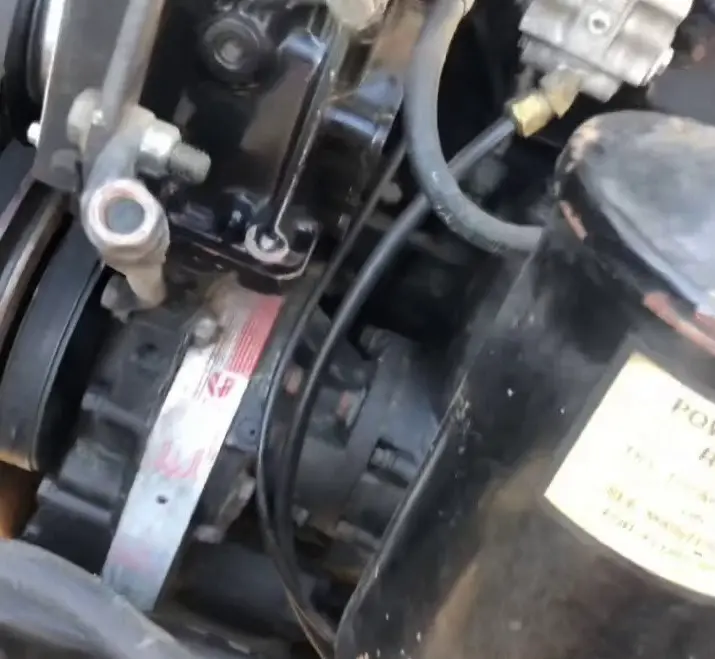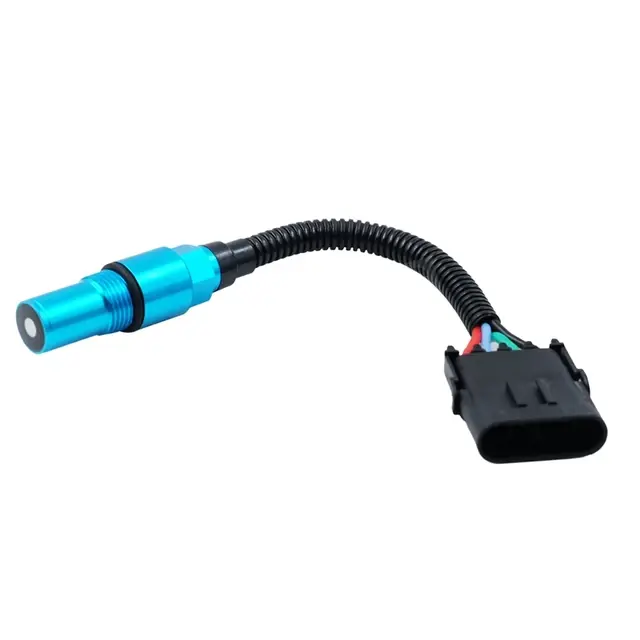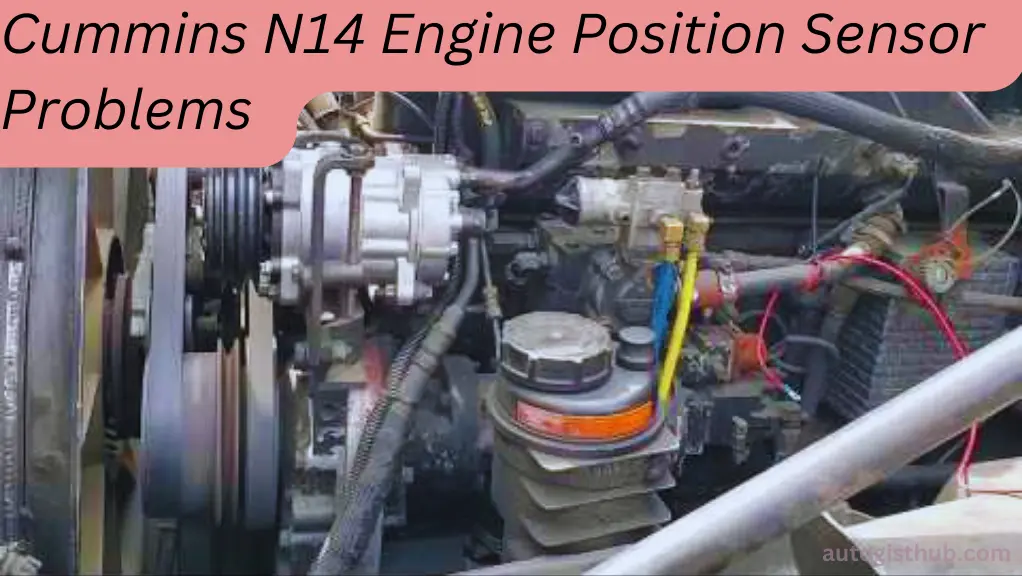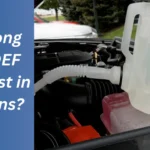The Cummins N14 engine is renowned for its power and performance, but it’s not without its share of issues. One recurring problem that plagues N14 owners is related to engine position sensors. These critical sensors can malfunction, leading to a range of performance and operational issues that demand immediate attention.
Common Symptoms Of Engine Position Sensor Issues
An engine position sensor is a crucial component in the Cummins N14 engine, responsible for determining the precise position of the engine’s crankshaft. When this sensor encounters issues, it can disrupt the engine’s performance and lead to various problems.
Engine stalling or misfires
One of the most noticeable symptoms of a faulty engine position sensor is stalling or misfires. When the sensor fails to accurately detect the crankshaft’s position, the engine may struggle to maintain a smooth idle or even shut down unexpectedly. This can result in a jumpy or uneven driving experience, putting both the driver and passengers at risk.
Difficulty starting the engine
A malfunctioning engine position sensor can also cause difficulties when starting the engine. When the sensor fails, it may not send the correct signals to the engine’s control module, making it harder for the engine to ignite and come to life. This can lead to frustrating and time-consuming efforts to start the vehicle, leaving you stranded and in need of a repair.
Decreased fuel efficiency
Another sign of engine position sensor problems is a notable decrease in fuel efficiency. Since the sensor plays a crucial role in determining the timing and control of fuel injection, a malfunction can lead to improper fuel management. This can result in excessive fuel consumption and reduced mileage, costing you more at the pump and impacting your overall efficiency.
Illuminated check engine light
One telltale sign of engine position sensor issues is the illumination of the Check Engine light on your dashboard. Modern vehicles are equipped with onboard diagnostic systems that monitor various sensors and components, including the engine position sensor. When a problem is detected, the Check Engine light will illuminate, indicating the need for immediate attention and potential repairs.
In conclusion, it’s essential to be aware of the common symptoms associated with engine position sensor issues in the Cummins N14 engine. If you experience engine stalling or misfires, difficulty starting the engine, decreased fuel efficiency, or an illuminated Check Engine light, it is crucial to have the engine position sensor inspected and repaired by a qualified technician.
Importance Of A Properly Functioning Engine Position Sensor
The engine position sensor plays a crucial role in the performance and functionality of any engine, including the Cummins N14 engine. This sensor ensures that the engine operates at its optimum capacity by providing essential data to the engine control unit. A properly functioning engine position sensor enhances ignition timing, monitors engine speed and position, facilitates proper fuel injection, and prevents any potential damage to engine components.

Ensures precise ignition timing
Precise ignition timing is vital for the efficient operation of any engine. The engine position sensor provides critical data to the engine control unit, enabling it to accurately determine the position of the engine’s crankshaft. With this information, the engine control unit can initiate spark plug firing at the precise moment, maximizing fuel efficiency and power output. A malfunctioning engine position sensor can result in timing errors, leading to reduced engine performance, increased fuel consumption, and potential misfires.
Monitors engine speed and position
The engine position sensor constantly monitors the speed and position of the engine’s crankshaft. This data helps the engine control unit maintain optimal performance levels. With accurate speed and position readings, the engine control unit can make real-time adjustments to various engine parameters, enabling the engine to deliver sufficient power and torque. Malfunctions in the engine position sensor can result in inaccurate speed and position readings, leading to engine stalling, hesitation, or even complete failure.
Enables proper fuel injection
The engine position sensor provides essential information to the engine control unit regarding the position of the crankshaft and piston. This data is crucial for the precise timing and duration of fuel injection. Proper fuel injection is essential to maximize fuel efficiency, reduce emissions, and maintain smooth engine operation. A malfunctioning engine position sensor can disrupt the fuel injection process, leading to poor fuel economy, increased emissions, and engine performance issues.

Prevents damage to engine components
A faulty engine position sensor can have severe consequences for engine components. With inaccurate speed and position data, the engine control unit may make incorrect timing adjustments, potentially causing severe engine damage.
A properly functioning engine position sensor ensures that the engine operates within its safe limits, preventing potentially catastrophic situations such as valve-to-piston interference. This safeguarding feature not only protects the engine but also saves you from costly repairs and downtime.
Causes Of Engine Position Sensor Problems
Sensor wiring issues
One of the common causes of engine position sensor problems in the Cummins N14 engine is sensor wiring issues. The engine position sensor, also known as the crankshaft position sensor, relies on electrical signals to accurately measure the position of the crankshaft. Any issues with the wiring connecting the sensor to the engine control module can disrupt the signal flow, leading to unreliable sensor readings and potential engine performance issues.
There are several reasons why sensor wiring issues may occur. First, the wiring harness may become damaged over time due to wear and tear or exposure to heat, chemicals, or moisture. Additionally, improper installation or routing of the wiring harness can lead to kinks, pinches, or breaks in the wire insulation, affecting the signal transmission.

To prevent sensor wiring issues, it is important to regularly inspect the wiring harness for any signs of damage, including frayed wires or loose connections. Additionally, proper installation and routing of the wiring harness according to manufacturer guidelines can help minimize the risk of wiring-related problems.
Sensor contamination or damage
Another common cause of engine position sensor problems in the Cummins N14 engine is sensor contamination or damage. The engine position sensor is typically located near the crankshaft and is exposed to various contaminants such as oil, dirt, and debris.
Over time, these contaminants can build up on the sensor’s surface or even penetrate the sensor housing, interfering with its functionality. Furthermore, physical damage to the sensor, whether due to impact or corrosion, can also impair its ability to accurately detect the crankshaft position.
Regular inspection and cleaning of the sensor can help prevent contamination-related issues. It is essential to use appropriate cleaning agents and follow the manufacturer’s recommendations to avoid damaging the sensor during the cleaning process. If physical damage is observed, the sensor should be replaced promptly to ensure accurate readings and prevent further damage to the engine.
Faulty sensor connectors
One more cause of engine position sensor problems in the Cummins N14 engine is faulty sensor connectors. The sensor connectors serve as the interface between the sensor and the engine control module, allowing the transmission of electrical signals. If the connectors become loose, dirty, or corroded, the signal connection may be compromised, leading to inaccurate sensor readings or complete sensor failure.
To prevent issues related to faulty sensor connectors, regular inspection and maintenance are crucial. Checking for any signs of connector damage, such as loose pins, corrosion, or debris buildup, can help identify potential issues early on. Cleaning the connectors using appropriate contact cleaner and ensuring a secure connection can help maintain reliable signal transmission and prevent engine position sensor problems.
How To Diagnose Engine Position Sensor Issues
When it comes to the smooth operation of your Cummins N14 engine, the engine position sensor plays a crucial role. This sensor provides valuable feedback to the engine control module (ECM), ensuring precise timing and fuel injection.
However, like any other component, the engine position sensor can also experience problems over time, leading to engine performance issues. Therefore, it is vital to be able to diagnose engine position sensor issues accurately. In this article, we will discuss three essential methods to diagnose engine position sensor problems.
Using diagnostic tools to scan for error codes
One of the most effective ways to diagnose engine position sensor problems is by using diagnostic tools that can scan for error codes. These tools connect to the ECM and retrieve any stored error codes related to the engine position sensor.
Error codes can indicate various issues, such as faulty sensor readings or communication problems between the sensor and ECM. By identifying these error codes, you can pinpoint the exact nature of the problem and take appropriate action.
Testing the sensor’s resistance and voltage readings
Another method to diagnose engine position sensor issues is by testing the sensor’s resistance and voltage readings. This requires a multimeter to measure the resistance and voltage levels at specific points on the sensor. Consult your engine’s service manual for the exact resistance and voltage specifications.
By comparing the measured values with the specified range, you can determine if the sensor is functioning correctly. If the readings are outside the recommended range, it indicates a potential problem with the sensor that needs attention.
Inspecting sensor wiring for damage or loose connections
In addition to testing the sensor itself, it is essential to inspect the sensor wiring for any signs of damage or loose connections. Faulty or damaged wiring can disrupt the signal transmission between the sensor and ECM, resulting in inaccurate readings or no readings at all.
Thoroughly examine the wiring harness for any visible signs of wear, such as frayed or exposed wires. Additionally, ensure that all connections are secure and tight. Address any wiring issues promptly to restore proper sensor function.
In conclusion, diagnosing engine position sensor problems is crucial for maintaining the optimal performance of your Cummins N14 engine. By utilizing diagnostic tools to scan for error codes, testing the sensor’s resistance and voltage readings, and inspecting sensor wiring for damage or loose connections, you can accurately identify and resolve any issues.
Regular maintenance and inspection are key to preventing significant problems and ensuring your engine continues to run smoothly.
Steps To Resolve Engine Position Sensor Problems
If you’re experiencing issues with the Cummins N14 engine position sensor, it can cause various performance problems and potentially leave you stranded on the side of the road. However, by addressing the problem quickly and effectively, you can get your engine back to running smoothly. In this article, we’ll discuss three crucial steps you can take to resolve engine position sensor problems. Let’s dive in!
Cleaning or Replacing the Sensor
The first step to tackle engine position sensor problems is to clean or replace the sensor. Over time, dirt, debris, and oil build-up can impair the sensor’s performance, leading to inaccurate engine position readings. To begin, locate the sensor, usually positioned on the front of the engine, near the camshaft or crankshaft.
If you notice heavy soiling or grime, you can clean the sensor carefully using a sensor-safe cleaner and a soft, lint-free cloth. Gently wipe away any dirt or oil, being cautious not to damage the sensor. However, if the sensor shows signs of damage or the cleaning doesn’t resolve the issue, it may be necessary to replace it altogether.
Repairing or Replacing Damaged Wiring
An engine position sensor problem can also stem from damaged or faulty wiring. Over time, wires can become frayed, corroded, or disconnected, interfering with the sensor’s ability to transmit accurate signals. To address this, inspect the wiring connected to the sensor, looking for any visible signs of damage or loose connections.
If you identify damaged wiring, you have two options: repair or replace it. For minor issues such as loose connections, carefully reconnect the wires, ensuring they are securely fastened. Conversely, for more severe damage like frayed or corroded wires, it’s best to replace the affected wiring entirely. This approach helps to ensure a long-lasting and reliable fix for your engine position sensor.
Checking and Securing Sensor Connectors
Another potential cause of engine position sensor problems lies in the sensor connectors. Over time, these connectors can loosen or become dislodged, leading to poor electrical connection and unreliable sensor readings. To verify the condition of the connectors, locate them near the sensor and visually inspect for any signs of looseness or disconnection.
If you identify any loose or dislodged connectors, secure them tightly to ensure a stable electrical connection. You may need specialized tools, such as pliers or a screwdriver, to fasten the connectors securely. This simple step can make a significant difference in the performance and accuracy of your engine position sensor.
By following these three crucial steps – cleaning or replacing the sensor, repairing or replacing damaged wiring, and checking and securing sensor connectors – you can effectively resolve engine position sensor problems related to your Cummins N14 engine.
As always, if you’re uncertain or uncomfortable performing these tasks yourself, it’s best to consult a qualified mechanic who can provide expert assistance. Don’t delay in addressing engine position sensor issues, as doing so promptly will help keep your engine running smoothly and reliably.
Tips For Preventing Engine Position Sensor Problems
The engine position sensor is a critical component in the Cummins N14 engine, responsible for providing crucial information to the engine control unit. However, like any other mechanical device, it can experience problems over time. Luckily, there are several preventive measures you can take to avoid engine position sensor problems and ensure the smooth operation of your engine.
Regularly inspecting sensor connections and wiring
One of the most common causes of engine position sensor issues is faulty connections and wiring. Over time, these connections can become loose or corroded, leading to intermittent or inaccurate sensor readings. To prevent such problems, it is essential to regularly inspect the sensor connections and wiring for any signs of damage or wear. This simple step can help you identify and fix any issues before they escalate into more significant problems.
Using clean and high-quality engine oil
Engine oil plays a crucial role in ensuring the smooth operation of your Cummins N14 engine. Using clean and high-quality engine oil can help in preventing engine position sensor problems. Dirty or low-quality oil can lead to increased friction and wear, which can affect the accuracy and performance of the sensor. Make sure to follow the manufacturer’s recommendations regarding the type and grade of engine oil to use and adhere to the recommended oil change intervals.
Avoiding excessive heat or moisture in the engine compartment
The engine compartment of your Cummins N14 engine can be a harsh environment, with high temperatures and moisture levels. Excessive heat and moisture can lead to corrosion, electrical shorts, and other issues that can impact the engine position sensor’s functionality.
To prevent such problems, ensure that the engine compartment is well-ventilated and that the cooling system is functioning correctly. Regularly check for any signs of coolant leaks or other sources of moisture that may affect the sensor’s performance.
Following the manufacturer’s maintenance recommendations
Manufacturers provide maintenance recommendations for a reason – to ensure the optimal performance and longevity of their engines. By following these recommendations, you can minimize the risk of engine position sensor problems and other issues.
Regularly schedule and perform the recommended maintenance tasks, including oil and filter changes, air filter replacements, and inspections. This will not only help in preventing sensor problems but also contribute to the overall health and efficiency of your Cummins N14 engine.
By implementing these preventive measures and giving due attention to the engine position sensor and its surroundings, you can minimize the risk of problems and ensure the smooth operation of your Cummins N14 engine. Regular inspections, proper lubrication, heat and moisture management, and adherence to manufacturer’s maintenance guidelines are all essential in preventing engine position sensor issues and maximizing the performance and reliability of your engine.
FAQs on Cummins N14 Engine Position Sensor Problems
A faulty position sensor can lead to inaccurate timing, misfire, and decreased fuel efficiency, affecting engine performance.
Symptoms include intermittent stalling, difficulty starting, erratic RPM readings, or sudden engine shutdown while driving.
Use a diagnostic scanner to identify sensor issues, then follow the engine manufacturer’s instructions to safely replace the faulty sensor.
Conclusion
To wrap it up, addressing position sensor problems in Cummins N14 engines is crucial for efficient operation and avoid potential breakdowns. Timely identification and resolution of these issues can save both time and money for the owners.
Regular maintenance checks, prompt repairs, and replacing faulty sensors are necessary steps to keep the engine running smoothly. By staying proactive, you can ensure the longevity and reliability of the N14 engine.




